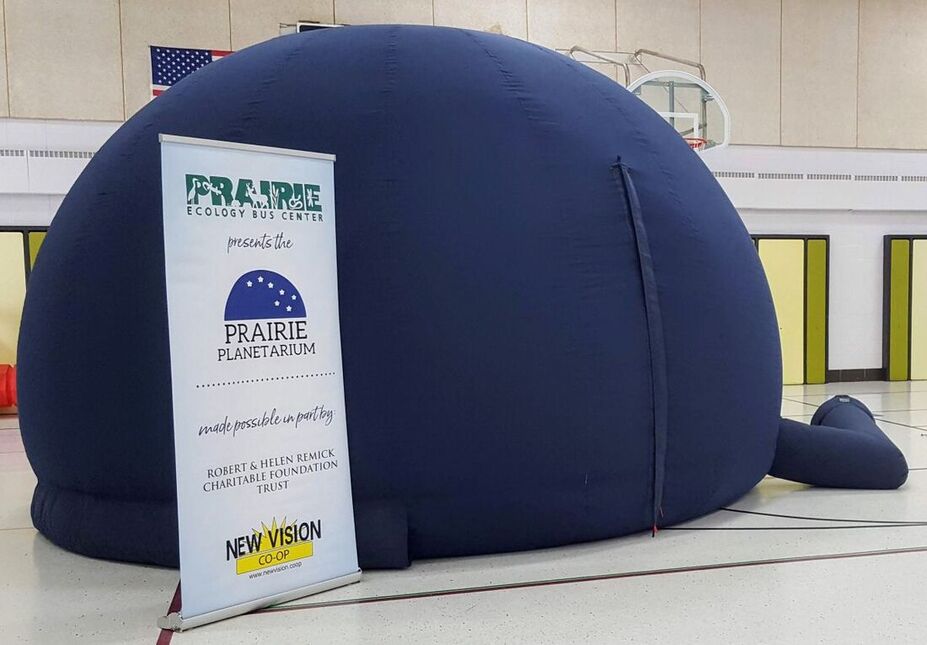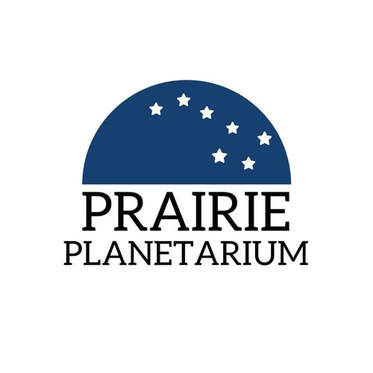The Prairie Planetarium is a portable, inflatable dome with a projector system that projects the stars and planets on the inside of the dome. Students are able to view that night’s sky from their hometown. Plus, fly anywhere and anytime in the solar system! Schedule multiple grades and a variety of programs on the same day.
The Prairie Planetarium is a portable, inflatable dome with a projector system that projects the stars and planets on the inside of the dome. Students are able to view that night’s sky from their hometown. Plus, fly anywhere and anytime in the solar system! Schedule multiple grades and a variety of programs on the same day.
Planetarium programs are between 45 minutes and 1 hour long. Portions of the program will be outside of the planetarium with the majority of the time spent inside the planetarium. Maximum capacity is 35 people. Fewer students will fit in the older grades and with more adults included. Program Rate: $200 for the first assembly, $150 for each additional assembly. Plus round trip mileage at current state mileage.
Visit Requirements
We cannot set up if the facility does not meet the following minimum requirements per the State Fire Marshal:
Planetarium programs are between 45 minutes and 1 hour long. Portions of the program will be outside of the planetarium with the majority of the time spent inside the planetarium. Maximum capacity is 35 people. Fewer students will fit in the older grades and with more adults included. Program Rate: $200 for the first assembly, $150 for each additional assembly. Plus round trip mileage at current state mileage.
- Ensure your facility can meet the visit requirements listed below.
- Review our program descriptions.
- Reservations must be made at least three weeks in advance.
- Email [email protected] or call (507)662-5064 with the following information: School/organization name; Choice of dates; Contact information
- Once final program details are finalized, we’ll send you a visit agreement for signature.
Visit Requirements
We cannot set up if the facility does not meet the following minimum requirements per the State Fire Marshal:
- There must be 14 feet or higher ceiling clearance so that sprinkler heads, smoke detectors and light fixtures will not be compromised.
- Minimum room dimensions must be 22’ x 22’ to allow for a safe emergency egress of three feet around the entire planetarium
- Two grounded 120-volt standard electrical outlets on separate circuits are required to power the dome. We may need to run extension cords across the floor.
- The Prairie Planetarium can only be set up indoors. There is no floor on the planetarium, so we recommend setting up on carpet if possible. Please make sure the floor is clean.
- Equipment arrives in heavy, wheeled cases. A ramp, large elevator or level entry is required - no stairs.
- Staff will need a 10 minute break between each session to reset the theater.
- Total setup time: 1 hour
- Total take down time: 45 minutes
Program Descriptions
Kindergarten
Sky Stories - 45 minutes
Introduce your students to the stars. Answer the question, “What is our favorite star,?” learn some of the constellation star stories, and why constellations are important today.
First Grade
What’s Up - 45 minutes
There is a lot going on in the night sky. Students will join an alien guide to learn about the Moon, stars, and planets and how they are all different from each other. Spot some constellations and hear the stories that go with them.
Second Grade
Moving Right Along - 45 minutes
Nothing stays in one place in space and that includes our planet, Earth! Students will learn how Earth is constantly spinning and revolving around the Sun, how this changes life on Earth through the year, how it changes our view of the stars through the year, and what constellations are currently visible.
Third Grade
Stellar Lunar - 1 hour
The Moon is our constant companion in space. Where did it come from, what are the phases of the Moon, and what is a lunar eclipse? Plus, see some seasonal constellations.
Fourth Grade
Planets - 1 hour
Journey through space to learn what makes a planet a planet? If you were to take a trip to each of the planets, what would it be like there? And how are all these planets moving through space?
Fifth Grade
Star Quest - 1 hour
Stars are born and have a life just like people do. What is that life cycle like? What are some important stars in our galaxy? And what are the stories told about them?
Middle School and Up
These programs are still in development. Please tell us what you are interested in (for example: planetary movement, stars and constellations, or space research missions) and we will see what is possible.
Kindergarten
Sky Stories - 45 minutes
Introduce your students to the stars. Answer the question, “What is our favorite star,?” learn some of the constellation star stories, and why constellations are important today.
First Grade
What’s Up - 45 minutes
There is a lot going on in the night sky. Students will join an alien guide to learn about the Moon, stars, and planets and how they are all different from each other. Spot some constellations and hear the stories that go with them.
Second Grade
Moving Right Along - 45 minutes
Nothing stays in one place in space and that includes our planet, Earth! Students will learn how Earth is constantly spinning and revolving around the Sun, how this changes life on Earth through the year, how it changes our view of the stars through the year, and what constellations are currently visible.
Third Grade
Stellar Lunar - 1 hour
The Moon is our constant companion in space. Where did it come from, what are the phases of the Moon, and what is a lunar eclipse? Plus, see some seasonal constellations.
Fourth Grade
Planets - 1 hour
Journey through space to learn what makes a planet a planet? If you were to take a trip to each of the planets, what would it be like there? And how are all these planets moving through space?
Fifth Grade
Star Quest - 1 hour
Stars are born and have a life just like people do. What is that life cycle like? What are some important stars in our galaxy? And what are the stories told about them?
Middle School and Up
These programs are still in development. Please tell us what you are interested in (for example: planetary movement, stars and constellations, or space research missions) and we will see what is possible.


